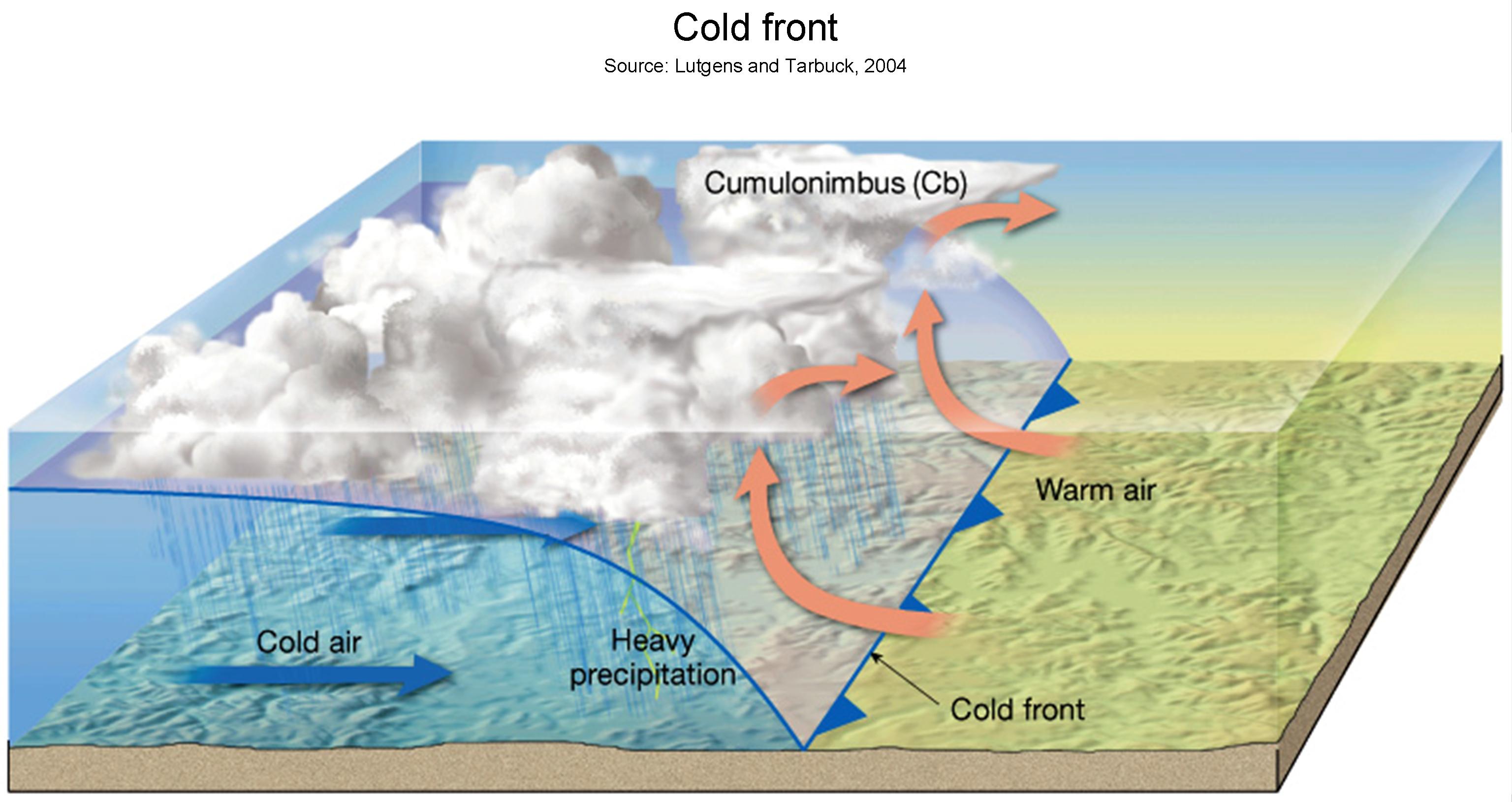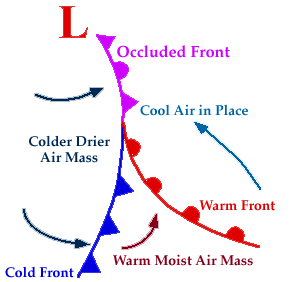Describe the techniques, and precautions that can be taken to manage the risks of VFR flight through fronts.
Determine a minimum height and minimum visibility range below which not to continue the flight
If these minima are encountered – land at nearest available place and wait for the front to pass
When cold fronts are forecast – the West coasts are affected more than the East coasts
Passage of warm fronts would dictate that both coasts would be problematic
Follow the adage – “when in doubt, turn about” for safety
Describe the potential dangers to VFR flight through fronts.
To maintain visual reference below the cloud base can become difficult, therefore flying at a lower height is required
Navigation becomes more difficult especially if in unfamiliar terrain and can become difficult to maintain visual reference with the ground
Poor visibility due to precipitation and low cloud
When flying along the coast there is a mixture of cloud precipitation and sea spray
There is a risk of low level wind shear
Damage to aircraft windshield and skin – from hail
Risk of icing if the freezing level is low and the combination of hail, snow and supercooled water are encountered
Limited or almost zero ability to manoeuvre the aircraft to a place where an unplanned landing can be made if circumstances dictate
Describe a cross section of the following occlusions and explain how each type develops:
a) cold occlusion;
b) warm occlusion.
a) Cold Occlusion
Warm air always lies above cold air
When the air behind the occluded front is colder than the air ahead of it this is a cold occlusion
b) Warm Occlusion
When the air behind the occluded front is warmer than the air ahead of it this is a warm occlusion
.png)
State the events before, at, and after, an idealised warm front in terms of:
a) pressure;
b) temperature;
c) wind velocity;
d) cloud;
e) precipitation;
f) visibility.
Warm Front Events
a) Pressure
Before the front – Pressure falls
At the front – Pressure fall is arrested
After the front – the Pressure remains steady or slightly rises
b) Temperature
Before the front – Temperature can be steady or slightly decreased
At the front – there is a slight increase in temperature
After the front – little or no change in temperature
c) Wind Velocity
Before the front – the wind veers and slightly increases in strength
At the front – the wind backs
After the front – the wind becomes steady in speed and direction
d) Cloud
Cloud before a warm front: – CI, C, AS, NS, Cb in unstable air
At a front – ST, NS or possibly CU, SC or Cb
After a warm front – there is no high cloud but low level cloud persisting
e) Precipitation
Before the front – Precipitation is light rain becoming heavy and persistent
At the front the rain eases or stops or changes to drizzle
After the front – precipitation becomes occasional drizzle or rain
f) Visibility
Before the front – good but poor in rain
At the front – Very poor
After the front – Fair visibility but reduced in rain or drizzle
Describe a cross section of the typical warm front including cloud, temperature and freezing level changes, precipitation, and typical width.
Cloud: – usually stratiform
Temperature: steady as the warm front approaches there is a usually gradual and subtle increase in temperature
Freezing level: changes ???????????
Precipitation: as the front approaches, precipitation becomes heavier and more persistent
Width: Often 1000kms
State the events before, at, and after, an idealised cold front in terms of:
a) pressure;
b) temperature;
c) wind velocity;
d) cloud;
e) precipitation;
f) visibility.
a) Pressure
Pressure before the cold front usually falls
As the front passes through – the pressure drop ceases
Afterwards the pressure rises
b) Temperature
Temperature before the cold front is steady,
It abruptly decreases as the cold front passes then is steadily cold afterwards
c) Wind Velocity
Before the cold front the wind velocity veers slightly and increases in strength
During the passage – wind can back suddenly and may involve squalls
After the passage – wind becomes steady in direction and slowly decreases in strength
d) Cloud
Prior to the cold front the cloud is usually CS or AS
During the passage it can be CU Cb and NS depends on degree of stability
After the front has passed – a rapid clearance may be evident in the isolated CU and Cb
e) Precipitation
Before the front – precipitation is unlikely and not common
At the front there may be heavy showers including hail
After the front the showers ease off quickly and become isolated
f) Visibility
Before the cold front – visibility is fair to good
At the front the visibility is very poor
After the front visibility improves again but can be reduced by showers
Describe the cross section of the typical cold front including cloud, temperature and freezing level changes, precipitation, and typical width.

Cross Section of Cold Front;
Cold air overtakes warm air which is less dense and the cold air will undercut and lift the warm air
Cloud – typically cumuliform
Temperature – steady before, then an abrupt drop during, then cold steady afterward
Freezing level –
Precipitation – Nil before then showers including hail as the front passes through, then easing of showers and isolated showers afterwards
Width – typically 150km on average
State the symbols, and colour codes, used to describe the following fronts on weather charts:
a) cold front;
b) warm front;
c) occluded front;
d) stationary front.
.jpg)
a) Cold Front
Lines with triangles on the advancing side
Lines are Blue
b) Warm Front
A Red line with half rounds on the advancing side
c) Occluded Front
Lines with triangles and half rounds on the same side
Purple lines
d) Stationary Front
Here advancing warm air is equally and directly opposed by advancing warm air
Can be a dashed line without symbols on a weather chart or blue / red lines
Triangles point into the warm part and half rounds point into the cold sector.


Describe the characteristics of the:
a) mid-latitude depression;
b) orographic depression;
c) thermal (heat type) depression.
a) Mid-latitude Depression
A depression forming in the mid-latitudes bringing in warm air from the tropics and sub-tropics
b) Orographic Depression
When a wind blows onto a mountain range some of the air is forced around the barrier and some goes partly over the top
This results in a “suction effect” on the lee side
This results in the formation of low pressures
c) Thermal (Heat type) depression
This is caused by the rising of air due to strong surface heating producing low level convergence for a localised depression to develop
Describe how divergence aloft affects the atmospheric pressure near sea level.
??????? DISCUSSION
With high level divergence (movement away) we get low level convergence.
.png)

.jpg)

